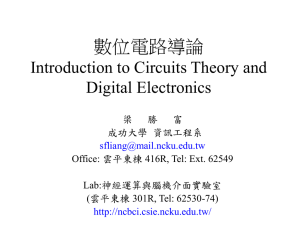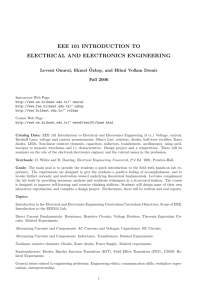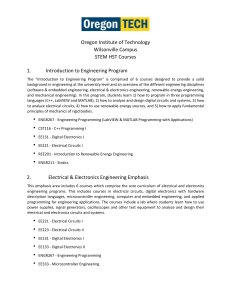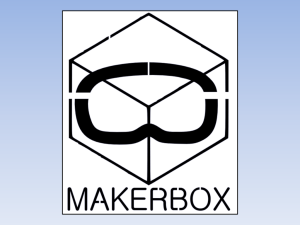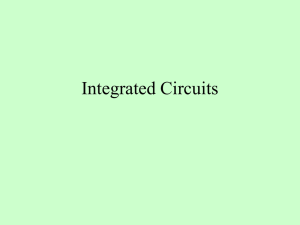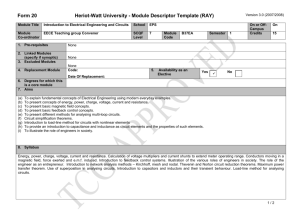CMP1101 Electronics I
advertisement
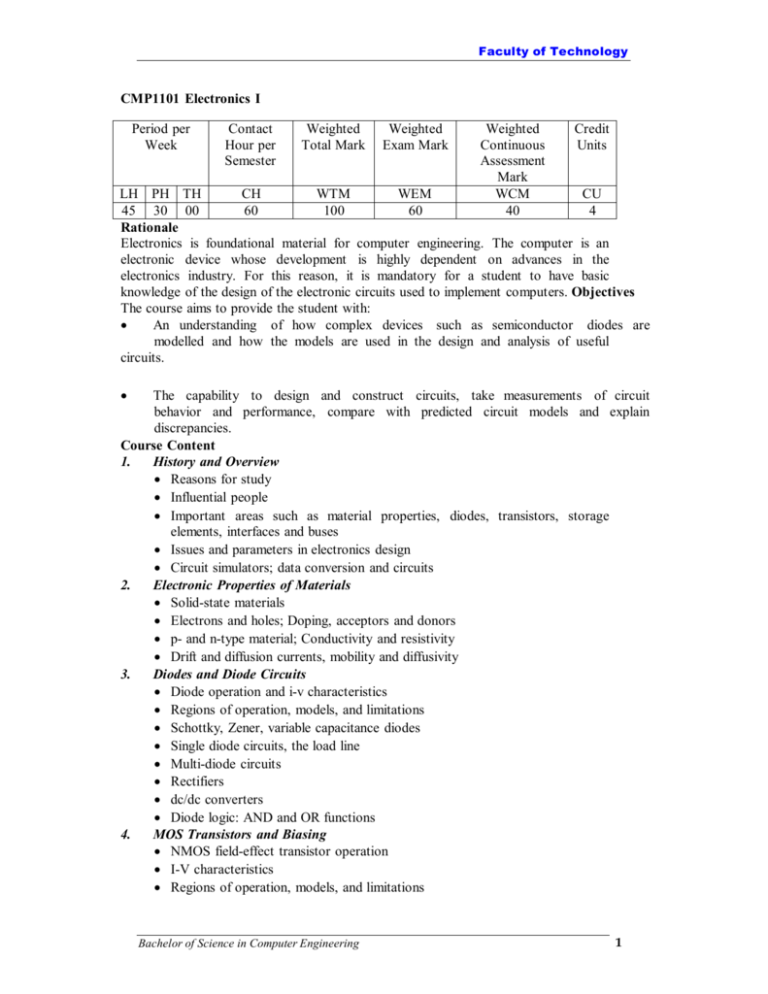
Faculty of Technology CMP1101 Electronics I Period per Week Contact Hour per Semester Weighted Total Mark Weighted Exam Mark Weighted Continuous Assessment Mark WCM 40 Credit Units LH PH TH CH WTM WEM CU 45 30 00 60 100 60 4 Rationale Electronics is foundational material for computer engineering. The computer is an electronic device whose development is highly dependent on advances in the electronics industry. For this reason, it is mandatory for a student to have basic knowledge of the design of the electronic circuits used to implement computers. Objectives The course aims to provide the student with: An understanding of how complex devices such as semiconductor diodes are modelled and how the models are used in the design and analysis of useful circuits. The capability to design and construct circuits, take measurements of circuit behavior and performance, compare with predicted circuit models and explain discrepancies. Course Content 1. History and Overview Reasons for study Influential people Important areas such as material properties, diodes, transistors, storage elements, interfaces and buses Issues and parameters in electronics design Circuit simulators; data conversion and circuits 2. Electronic Properties of Materials Solid-state materials Electrons and holes; Doping, acceptors and donors p- and n-type material; Conductivity and resistivity Drift and diffusion currents, mobility and diffusivity 3. Diodes and Diode Circuits Diode operation and i-v characteristics Regions of operation, models, and limitations Schottky, Zener, variable capacitance diodes Single diode circuits, the load line Multi-diode circuits Rectifiers dc/dc converters Diode logic: AND and OR functions 4. MOS Transistors and Biasing NMOS field-effect transistor operation I-V characteristics Regions of operation, models, and limitations Bachelor of Science in Computer Engineering 1 Faculty of Technology Enhancement and depletion-mode devices PMOS devices Transfer characteristic of FET with load resistor Biasing for logic and amplifier applications 5. MOS Logic Families Logic level definitions NMOS logic design: Inverter, NOR, NAND, SOP, POS, complex gates PMOS logic CMOS logic: Inverter, NOR, NAND, SOP, POS, complex gates Dynamic logic CVS logic Cascade buffers NMOS and CMOS power/delay scaling Learning Outcomes Identify some contributors to electronics and relate their achievements to the knowledge area; describe a transistor and its functionality; identify some storage elements; articulate the purpose of buses; indicate the importance of designing data conversion circuits; identify two software products used for designing and simulating circuits; and describe how computer engineering uses or benefits from electronics. Indicate the properties of materials that lead to be useful for the construction of electronic circuits, giving reasons; and explain the uses of one particular material (as opposed to alternatives) to serve a stated purpose. Explain the properties of diodes; and outline the use of diodes in the construction of a range of circuits including rectifiers, ac/dc converters, and common logic functions. Indicate the areas of use of NMOS, PMOS, CMOS, and dynamic logic families; and demonstrate the ability to implement a range of logic functions using each of NMOS, PMOS, CMOS, and dynamic logic. Explain the differences between the different MOS logic families; and articulate the advantages of dynamic logic. Recommended and References Books [1] Agarwal, Anant, and Jeffrey H. Lang. Foundations of Analog and Digital Electronic Circuits. San Mateo, CA: Morgan Kaufmann Publishers, Elsevier, July 2005. ISBN: 9781558607354. th [2] Earl D. Gates, Introduction to Electronics, 4 ed., Thomson, 2004 [3] D. C. Green, Electronics 4, 3rd ed., Longman, 1995 Bachelor of Science in Computer Engineering 2


